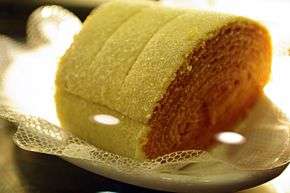Bolo de rolo
|
The bolo de rolo, one of the symbols of Pernambuco. | |
| Place of origin | Brazil |
|---|---|
| Region or state | Pernambuco |
| Main ingredients | Flour, eggs, butter, sugar, goiabada |
|
| |
Bolo de rolo (English translation: rollcake) is a typical Brazilian dessert, from Pernambuco state.
The cakebatter is made with flour, eggs, butter and sugar. This dough is wrapped with a layer of melted guava, giving the appearance of a swiss roll. However, layers of dough and guava are much thinner than the ones used in the swiss roll, and the taste is completely different.
Its origin lies in the adaptation of Portuguese cake colchão de noiva (bride's mattress), a kind of sponge cake rolled with a filling of nuts. Upon arriving in Brazil, the Portuguese cooks changed the filling to guava fruit, which is plentiful in northeastern Brazil, cooked with sugar, which was abundant since it was made in the factories of the region. Even today it is common to sprinkle the bolo de rolo with sugar in its outer shell, snapping up the presentation of the dessert.
Ordinary Law № 379/2007: bolo de rolo was recognized as intangible heritage of Pernambuco.[1]
See also
References
Further reading
- Hamilton, Cherie (2005). Brazil: A Culinary Journey. New York: Hippocrene Books. p. 83. ISBN 0-7818-1080-9.
